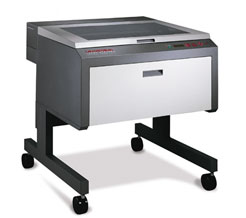
Food Channel Features Laser
SCOTTSDALE, Ariz., May 24, 2007 -- A CO2 laser system made by Universal Laser Systems Inc. of Scottsdale, Ariz., had a prominent role in a recent Food Network Special series, "Kitchens of the Future," which aired in April. Narrated by Food Network personality Alton Brown, the show included a nostalgic kitchen gadget restrospective and a look at culinary gizmos on the horizon.
In the segment featuring the Universal Laser System (model M-360), Brown cited Massachusetts Institute of Technology research in how lasers can mark food products with text, logos  and graphics. Inventor Ted Selker demonstrated the ability of the machine to etch nutritional information on the surface of a Pop-Tart toaster pastry (The Food Channel logo was also engraved onto a Pop-Tart with Brown's voice-over, "And that’s what the food of tomorrow might look like in the kitchen of the future.")
and graphics. Inventor Ted Selker demonstrated the ability of the machine to etch nutritional information on the surface of a Pop-Tart toaster pastry (The Food Channel logo was also engraved onto a Pop-Tart with Brown's voice-over, "And that’s what the food of tomorrow might look like in the kitchen of the future.")
A Universal Laser Systems C02 laser marking system
Selker is an associate professor at the MIT Media and Arts Technology Laboratory, where he is director of the Context Aware Computing Lab and of the Counter Intelligence (CI) program (which has a forum on kitchens and domestic technology, lifestyles and supply changes as a result of technology www.media.mit.edu/ci/).
CI projects include developing new takes on vending machine designs and payment systems and how they interact with customers; oven cameras that allow a cook to keep an eye on and adjust controls for dishes in progress from anywhere in the house; Robocrop, which combines sensors, networking and plants to create a modular desktop gardening system; the Chameleon mug, which investigates a way to make handheld computers for the kitchen. (Using LCD, bimetal strips, thermoresister and thermochromic ink as sensors; a vessel changes color, displays safety messages or springs a handle to indicate whether a fluid in it is hot or cold.) Selker is also experimenting with tables that can be connected mechanically and electronically to make a larger surface.
David Wilhite, marketing coordinator at Universal Laser Systems, said CO2 lasers can quickly and easily lend a personal touch to foods. "I am familiar with applications that include laser-marking steaks with corporate logos to give as gifts, and personalizing chocolate and cheese," he said. (The company also processes materials such as glass, leather, plastics, metals, ceramics, rubber and marble; its systems are used in the woodworking, awards and custom gifts, signmaking and embroidery industries, and in industrial fields.)
Far from being just the icing on a Pop-Tart, though, CO2 laser marking has a serious role in the food industry. According to Industrial Laser Solutions magazine, "The obvious advantages of noncontact laser marking are well-known, but for the produce packing market, it also means instant PLU (product lookup) changeover, elimination of high-cost adhesive labels, no-waste and low-energy costs, environmental and health compatibility, traceability, information storage, no consumables, no additional personnel required, and the ability to do COOL (country-of-origin labeling), when it is finally required."
Pending US government requirements for identifying single units of produce with a country-of-origin label prompted the development of an adhesive label carrying, for now, product lookup codes. Other methods, such as inkjet marking, had legibility issues, the trade magazine said.
For more information, visit: www.ulsinc.com/
/Buyers_Guide/Universal_Laser_Systems_Inc/c15512